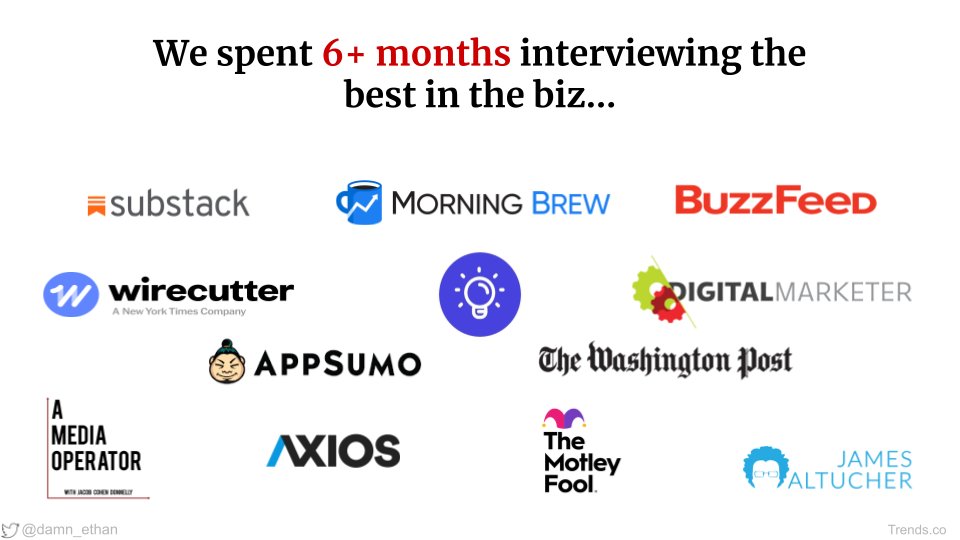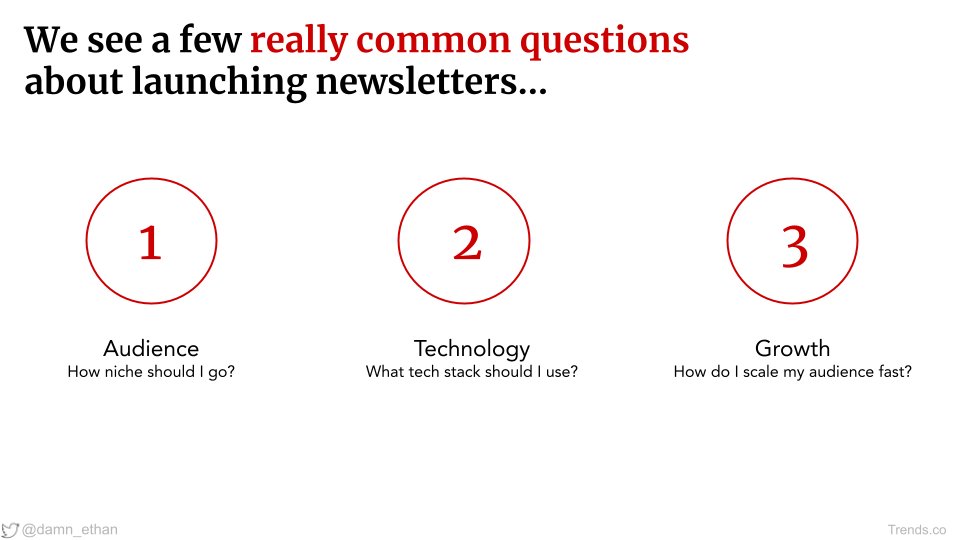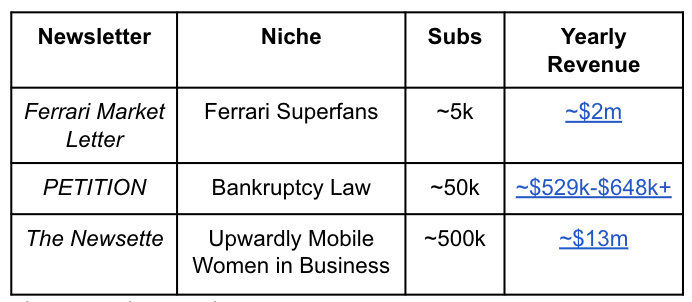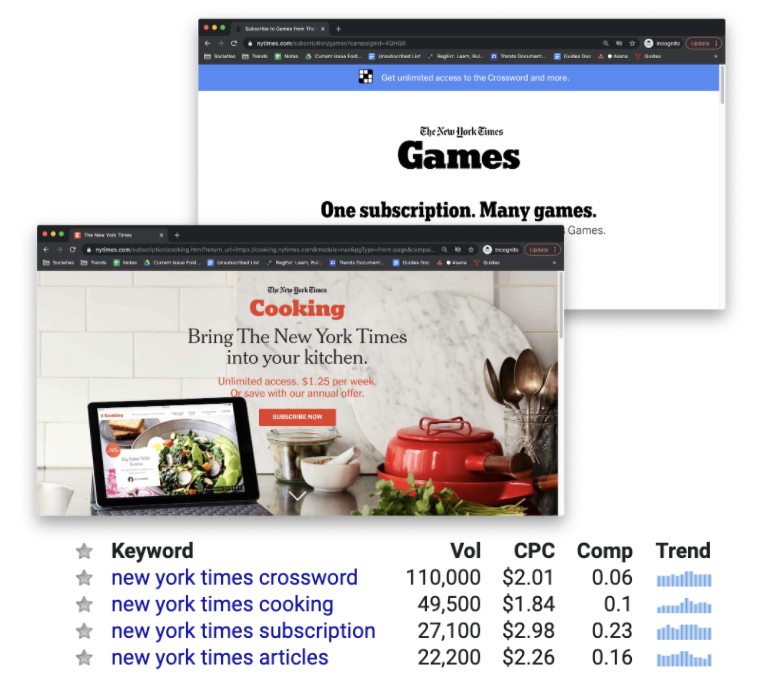
"How 7-Figure Newsletters Make Money"
For the last few weeks, I've been doing this talk, based on 6+ months of dedicated research.
Time to see if it translates well to Twitter. For your viewing pleasure...🧵
For the last few weeks, I've been doing this talk, based on 6+ months of dedicated research.
Time to see if it translates well to Twitter. For your viewing pleasure...🧵

First a little background:
Newsletters are having a moment. People want to know how they work.
At The Hustle, we set out to write the definitive industry guide, and found that people have a lot of questions...
Newsletters are having a moment. People want to know how they work.
At The Hustle, we set out to write the definitive industry guide, and found that people have a lot of questions...

Of all these questions, one was most important:
"Which kind of newsletter should I build... Paid or free?"
Crucial because:
1️⃣ The answer impacts your entire growth plan
2️⃣ We found most people are actually thinking wrong about this...
"Which kind of newsletter should I build... Paid or free?"
Crucial because:
1️⃣ The answer impacts your entire growth plan
2️⃣ We found most people are actually thinking wrong about this...

I won't bury the lead... The answer is: "It's not about one or the other, you should eventually build both."
Let me show you why...
Let me show you why...
There are 3 main ways to make money from a newsletter:
1️⃣ Free subscriptions (monetized via ads)
2️⃣ Low-price subscriptions
3️⃣ High-price subscriptions
Alone, each can be a multi-million dollar biz. But together they're better...
1️⃣ Free subscriptions (monetized via ads)
2️⃣ Low-price subscriptions
3️⃣ High-price subscriptions
Alone, each can be a multi-million dollar biz. But together they're better...

When you (eventually) build all 3, you diversify your income which protects you from market changes.
You also grow the lifetime value of readers, pulling them deeper into your eco-system.
You start by building your free list...
You also grow the lifetime value of readers, pulling them deeper into your eco-system.
You start by building your free list...

Very briefly, there seem to be 3 things that trip people up when *starting* a free newsletter. They ask:
-How niche should it be?
-What tech stack should I use?
-How do I scale my audience?
After speaking to many media leaders, here are the no BS answers to each of those...
-How niche should it be?
-What tech stack should I use?
-How do I scale my audience?
After speaking to many media leaders, here are the no BS answers to each of those...

1) "How niche should it be?"
Short answer: The nicher, the better. There are riches in niches and a small audience can offer serious cashflow. Examples below 👇
Click here for more thoughts on this from @danoshinsky: docs.google.com/presentation/d…
Short answer: The nicher, the better. There are riches in niches and a small audience can offer serious cashflow. Examples below 👇
Click here for more thoughts on this from @danoshinsky: docs.google.com/presentation/d…

2) "What tech should I use?"
Short answer: Until you're sending ~100k emails/day, your tech stack doesn't really matter. Pick what looks easiest / most affordable and focus on publishing a kick-ASS newsletter.
MailChimp is most popular at that stage.
Short answer: Until you're sending ~100k emails/day, your tech stack doesn't really matter. Pick what looks easiest / most affordable and focus on publishing a kick-ASS newsletter.
MailChimp is most popular at that stage.

3) "How do I scale my audience?"
Short answer: Focus on growing trust, rather than growing your audience.
@Codie_Sanchez grew Contrarian Thinkers newsletter to ~10k in 30 days. You can hear more from her on that here: docs.google.com/presentation/d…
Short answer: Focus on growing trust, rather than growing your audience.
@Codie_Sanchez grew Contrarian Thinkers newsletter to ~10k in 30 days. You can hear more from her on that here: docs.google.com/presentation/d…
The big thing early on is this:
You don't need to make the perfect decisions. Just don't get stuck.
So... When is your audience big enough to monetize? I'll tell you, but first a disclaimer...
You don't need to make the perfect decisions. Just don't get stuck.
So... When is your audience big enough to monetize? I'll tell you, but first a disclaimer...
When people ask about monetizing the answer they usually get is "It depends."
It's unsatisfying, but true. This depends on factors like your niche, engagement, etc...
I'll give you concrete numbers. But I'll also show you the factors at play, so you can decide for yourself...
It's unsatisfying, but true. This depends on factors like your niche, engagement, etc...
I'll give you concrete numbers. But I'll also show you the factors at play, so you can decide for yourself...
So, generally speaking, you are ready to monetize a free newsletter when you have at least 2 of the following:
1️⃣ Large audience (~80k+)
2️⃣ High unique opens (20%+)
3️⃣ Readers willing to spend $$$
I'll show you why these numbers in a sec...
1️⃣ Large audience (~80k+)
2️⃣ High unique opens (20%+)
3️⃣ Readers willing to spend $$$
I'll show you why these numbers in a sec...

An audience willing to spend money is crucial. This impacts everything, including:
-The types of products you can advertise
-How much you can charge advertisers
-How much you can charge for paid subscriptions later
So build an audience willing to spend money.
-The types of products you can advertise
-How much you can charge advertisers
-How much you can charge for paid subscriptions later
So build an audience willing to spend money.

There are 2 popular ways to monetize a free newsletter:
-Affiliate Deals
-Ads
Affiliate deals are easier to start with because you can do it with a smaller audience and many programs are self-serve.
The pro's say check out @shareasale @CJNetwork and @Rakuten
-Affiliate Deals
-Ads
Affiliate deals are easier to start with because you can do it with a smaller audience and many programs are self-serve.
The pro's say check out @shareasale @CJNetwork and @Rakuten
To sell ads in a newsletter, and make it worth your time, you'll need a bigger audience.
Often ~75k-80k readers is where it starts to make sense.
For more on that, check out the detailed sample pricing tables here: docs.google.com/presentation/d…
So how do you actually sell ads?...
Often ~75k-80k readers is where it starts to make sense.
For more on that, check out the detailed sample pricing tables here: docs.google.com/presentation/d…
So how do you actually sell ads?...

Our top ad slinger at The Hustle sold millions in ads. She used the BANT framework to vet clients, making sure they had:
-Budget to afford us
-Authority to make a decisions
-Need to reach our audience
-Timing - needed us now
Where did she find them?...
-Budget to afford us
-Authority to make a decisions
-Need to reach our audience
-Timing - needed us now
Where did she find them?...

To find ad clients, she always monitored:
-Advertisers in competing newsletters
-Recent funding reports in @TechCrunch, @crunchbase, or @danprimack Axios Pro-Rata newsletter.
When startups raise money, they get new growth goals (i.e. great time to advertise)
-Advertisers in competing newsletters
-Recent funding reports in @TechCrunch, @crunchbase, or @danprimack Axios Pro-Rata newsletter.
When startups raise money, they get new growth goals (i.e. great time to advertise)
Early on, you don't need a fancy approach to sell ads for your newsletter.
You can literally read the step-by-step emails @theSamParr used to sell some of the first Hustle ads here: docs.google.com/presentation/d…
You can literally read the step-by-step emails @theSamParr used to sell some of the first Hustle ads here: docs.google.com/presentation/d…

But as your business grows, you'll want to develop 3 types of ad inventory:
-Premium Ad: Most expensive
-Down-sell: More affordable (but smaller)
-Loss leader: Cheap and very small
These work together to close deals and maximize revenue. Here's how...
-Premium Ad: Most expensive
-Down-sell: More affordable (but smaller)
-Loss leader: Cheap and very small
These work together to close deals and maximize revenue. Here's how...

You start by offering your premium ad. If it's out of the client's budget, you have 2 options:
1️⃣ Offer the smaller, less expensive down-sell.
2️⃣ Toss in the loss-leader as a free bonus to sweeten the pot.
Let's look at how this plays out in the real world...
1️⃣ Offer the smaller, less expensive down-sell.
2️⃣ Toss in the loss-leader as a free bonus to sweeten the pot.
Let's look at how this plays out in the real world...
This is an old rate-card from Morning Brew. Look at the Daily Brew. If a client hesitates over the primary ad, MB can:
-Down-sell to the secondary ad, or...
-Offer a free Brews Bets ($10k in value) along with the primary.
That's just 1 example of how the 3 tiers work together.
-Down-sell to the secondary ad, or...
-Offer a free Brews Bets ($10k in value) along with the primary.
That's just 1 example of how the 3 tiers work together.

You can grow quite large with just this setup. Last year, Morning Brew did $20m+ with just a few free newsletters. 

But eventually, you'll want to consider paid newsletters.
It's NOT that paid newsletters drive MORE revenue (though they can)...
It's that they earn a DIFFERENT kind of revenue -- recurring revenue.
It's NOT that paid newsletters drive MORE revenue (though they can)...
It's that they earn a DIFFERENT kind of revenue -- recurring revenue.

If you sell $1m worth of ads this year, that's great. But come next year, you have to do it all over again.
More if you want to grow.
But if you sell $1m worth of subscriptions, and 50% renew, you start the year with $500k in the bank. That's the beauty of recurring revenue.
More if you want to grow.
But if you sell $1m worth of subscriptions, and 50% renew, you start the year with $500k in the bank. That's the beauty of recurring revenue.

There are 2 types of paid newsletters. The main difference is their price/level of specificity:
-Front-End Products (typically $5-10/mo)
-Back-End Products (typically $500-$1k/yr and up)
@jaltucher is the master of this system. More from him here: docs.google.com/presentation/d…
-Front-End Products (typically $5-10/mo)
-Back-End Products (typically $500-$1k/yr and up)
@jaltucher is the master of this system. More from him here: docs.google.com/presentation/d…

You're basically looking for parts of your free newsletter that people would be willing to pay for on their own.
For example, NYT realized people searched for games & cooking more than their articles.
So they split those off into stand-alone front-end products.
For example, NYT realized people searched for games & cooking more than their articles.
So they split those off into stand-alone front-end products.

The big thing: There's no limit to the number of media properties you can spin up using this model.
@ryandeiss thinks of it like a solar system, with brand moons that orbit core media properties.
Each new one helps grow the others: docs.google.com/presentation/d…
@ryandeiss thinks of it like a solar system, with brand moons that orbit core media properties.
Each new one helps grow the others: docs.google.com/presentation/d…

Not only do paid newsletters give you recurring revenue -- they can protect you from drops in the ad market (and vice-versa)
Here's a look at NYT's revenue for the last decade.
Notice anything?
Here's a look at NYT's revenue for the last decade.
Notice anything?

So the question isn't really whether you should build free or paid.
In the long run, you want to build both.
You start with free. Then use it to support and market your paid products.
In the long run, you want to build both.
You start with free. Then use it to support and market your paid products.

If this was helpful, go ahead and follow me (@damn_ethan).
I have 300+ pages of distilled research to share, and my next major presentation is all about how to figure out your budget for paid growth.
DM if you have questions or want me on your podcast. Happy to share more!
I have 300+ pages of distilled research to share, and my next major presentation is all about how to figure out your budget for paid growth.
DM if you have questions or want me on your podcast. Happy to share more!
You can see the full slide deck for free here: bit.ly/3mJmc1y
Or check out the talk with much more detail and a Q&A here 👇:
Fair warning, my hair looks better in this illustration than real life.
trends.co/video/an-insid…
Or check out the talk with much more detail and a Q&A here 👇:
Fair warning, my hair looks better in this illustration than real life.
trends.co/video/an-insid…
• • •
Missing some Tweet in this thread? You can try to
force a refresh





